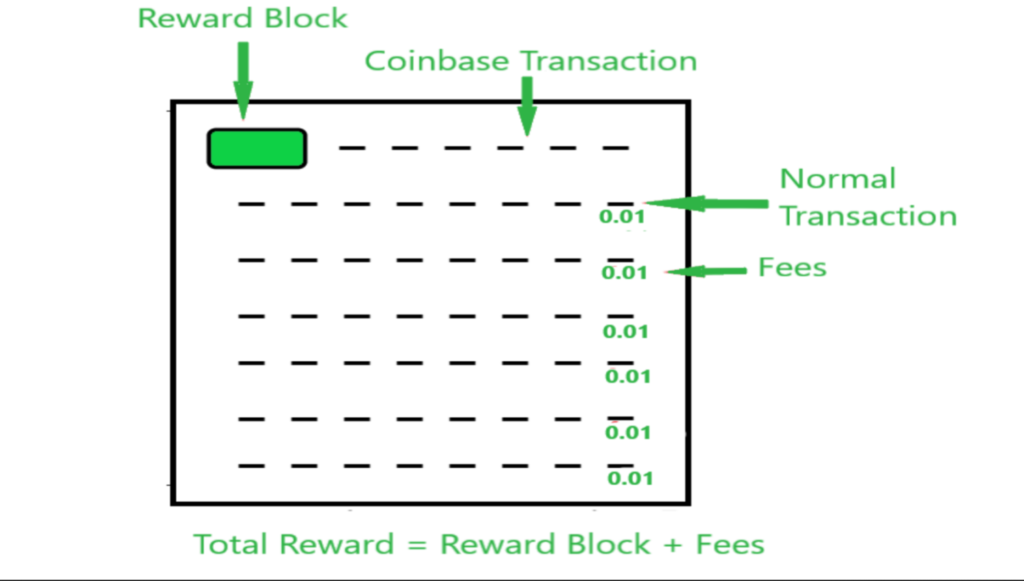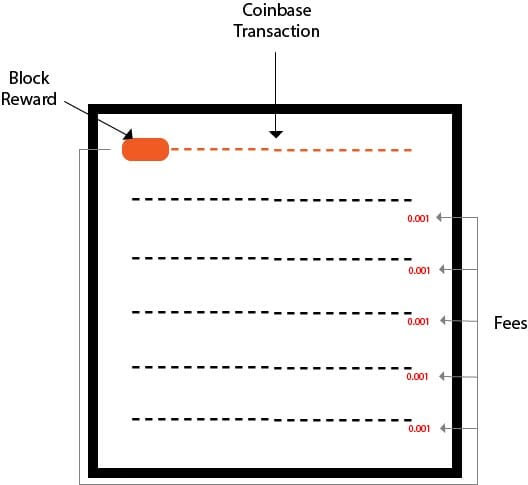and the distribution of digital products.
What is a Coinbase Transaction?
A block is created and immediately added to the blockchain when all transactions on the bitcoin network are consolidated. These blocks are now immutable and tamper-proof for all transactions. The Coinbase transaction created by the miner is the first transaction of the block. While any other transaction fees collected by the miner are also sent in this transaction, miners collect their reward. Each block must contain one or more successful transactions in addition to the Coinbase transaction.
 Coinbase Transaction
Detailed Summary
Coinbase Transaction
Detailed Summary
- The first transaction in a block is called a Coinbase transaction and is not the payment between two individuals.
- It’s a unique transaction that formats specially allocated reward transactions for miners inside the genesis block.
- The reward generated from this transaction points to the cryptocurrency wallet address of the miner, and depending on the individual’s choice, it can point to more than one wallet.
- The block reward, when collected, also includes the fee charged by the user for each transaction.
- A certain number of blockchain confirmations (Coinbase maturity) are required before the rewards of a Coinbase transaction can be used. For example, Bitcoin requires 100 confirmations before the reward can be used.
- After a certain number of blocks are successfully added to the blockchain, the reward is split in half. This process is known as halving.
- To calculate the value of Coinbase transactions, the value of each input is verified, the height of the block is considered, and finally, considering the halving respective to the block, the coinbase transaction is created by the miner, including the total reward and fee.
Also Read: How Bitcoin Mining Work? [Technical]
What are Wallets and Transactions?A crypto wallet is a safe and accessible way to store your cryptocurrencies. They help you send and receive cryptocurrencies whilst being where rewards for Coinbase transactions are pointed to. Wallets are of three types: Paper, Hardware, and Online.
Transactions refer to the movement of cryptocurrencies and funds from one wallet to another. The Coinbase transaction time varies according to the different geographical regions, payment methods, and locations.
ACH Coinbase TransferIt is a computer-based electronic network used for processing transactions that are usually low-value domestic payments. It charges low fees and is designed to process batches of payments containing numerous transactions. The funds will be debited immediately from the account, but they will not appear on the wallet until they have moved between the banks and processed successfully.
What is the Genesis Block?The Genesis Block, or Block 0, is the first block in a blockchain upon which subsequent blocks were placed. As every block refers to the one before it, it is the ancestor to whom all subsequent blocks may trace their history. Each block is accompanied by a unique header by which it is identified. The blocks are then stacked on each other with the Genesis Block as the foundation. They grow in height till the sequence is completed and the end of the blockchain is reached.
 Coinbase Transaction
Coinbase Transaction
Also read, Metamask vs Coinbase Wallet: Lowest Fee Crypto Wallet
How is Staking related to Coinbase Transactions?Staking is a way of earning rewards by holding particular cryptocurrencies. It is the process of actively participating in transaction validation (similar to mining) on a proof-of-stake (PoS) blockchain. Anyone with a minimum-required balance of a specific cryptocurrency can verify transactions and earn Staking rewards on these blockchains.
Details about Stacking- When the minimum balance is catered, similar to a security deposit, a node deposits the amount into the network as a stake.
- A stake’s size is directly proportional to the possibility of that node being chosen to form the next block.
- If the node successfully creates a block, similar to how a miner is rewarded in proof-of-work chains, the validator receives a reward.
- Validators lose a portion of their stake when they double-sign or attempt attacking the network.
Also read, Lido Review: Staking with Highest Interests
What is the structure of a coinbase transaction?A bitcoin transaction is just the information that demonstrates the transfer of bitcoins from one wallet to another. Because Coinbase transactions produce new currencies that have never been spent, the input field in such transactions is left blank. ‘The Coinbase’ is the only blank input of a Coinbase transaction. Since it collects Bitcoin funds from Coinbase and other transactions, a Coinbase transaction has no inputs to represent outputs of older transactions.
ConclusionA block’s first transaction is called the Coinbase transaction, and it is not the payment between two individuals. It’s a unique transaction that formats specially allocated reward transactions for miners inside the genesis block. The reward generated from this transaction points to the cryptocurrency wallet address of the miner, and depending on the individual’s choice, it can point to more than one wallet.
Frequently Asked Questions Q1. What is a Coinbase transaction?A1. The first transaction in a block is not the payment between two individuals.
Q2. Why is a Coinbase transaction unique?A2. Coinbase Transaction is a unique transaction that formats specially allocated reward transactions for miners inside the genesis block. The reward generated points to the cryptocurrency wallet address of the miner and, depending on the individual’s choice, can point to more than one wallet.
Also read,
- Home
- About Us
- Write For Us / Submit Content
- Advertising And Affiliates
- Feeds And Syndication
- Contact Us
- Login
- Privacy
All Rights Reserved. Copyright , Central Coast Communications, Inc.